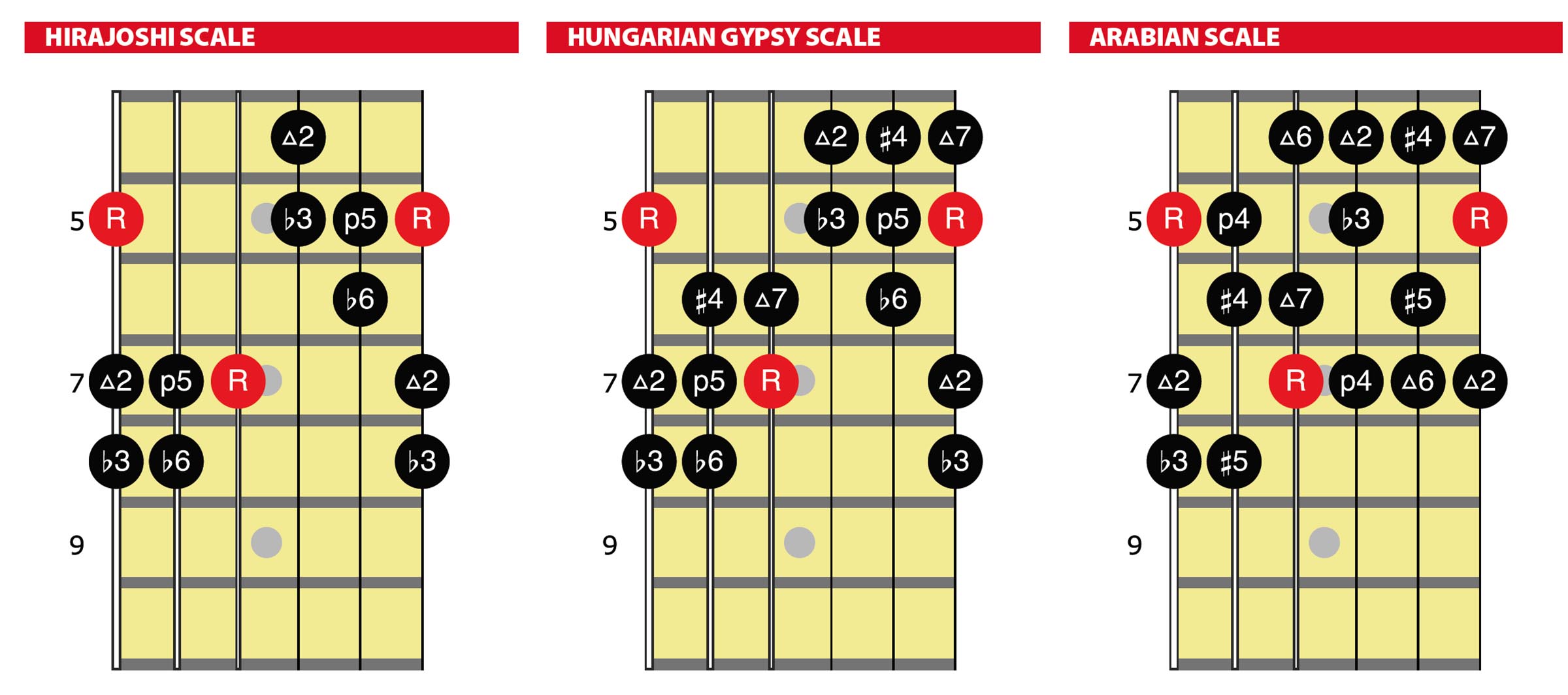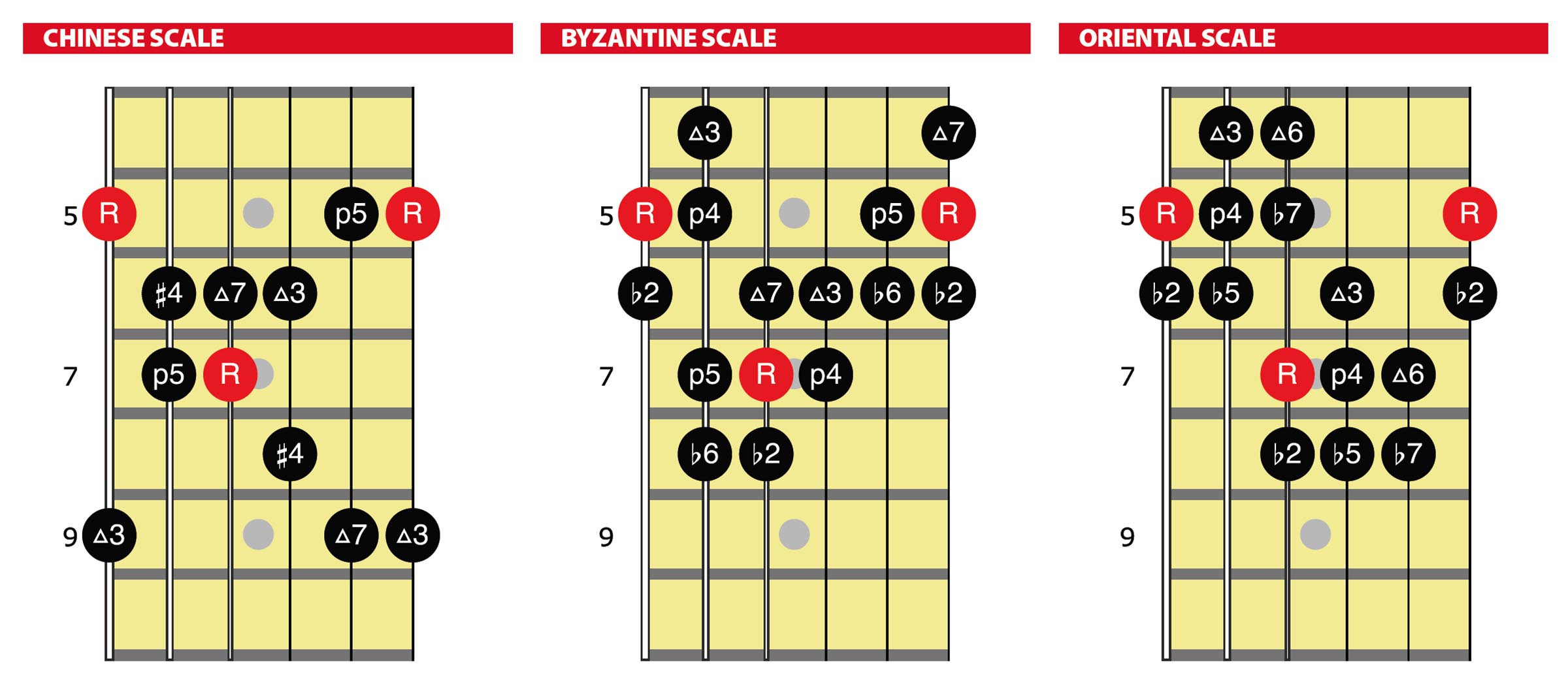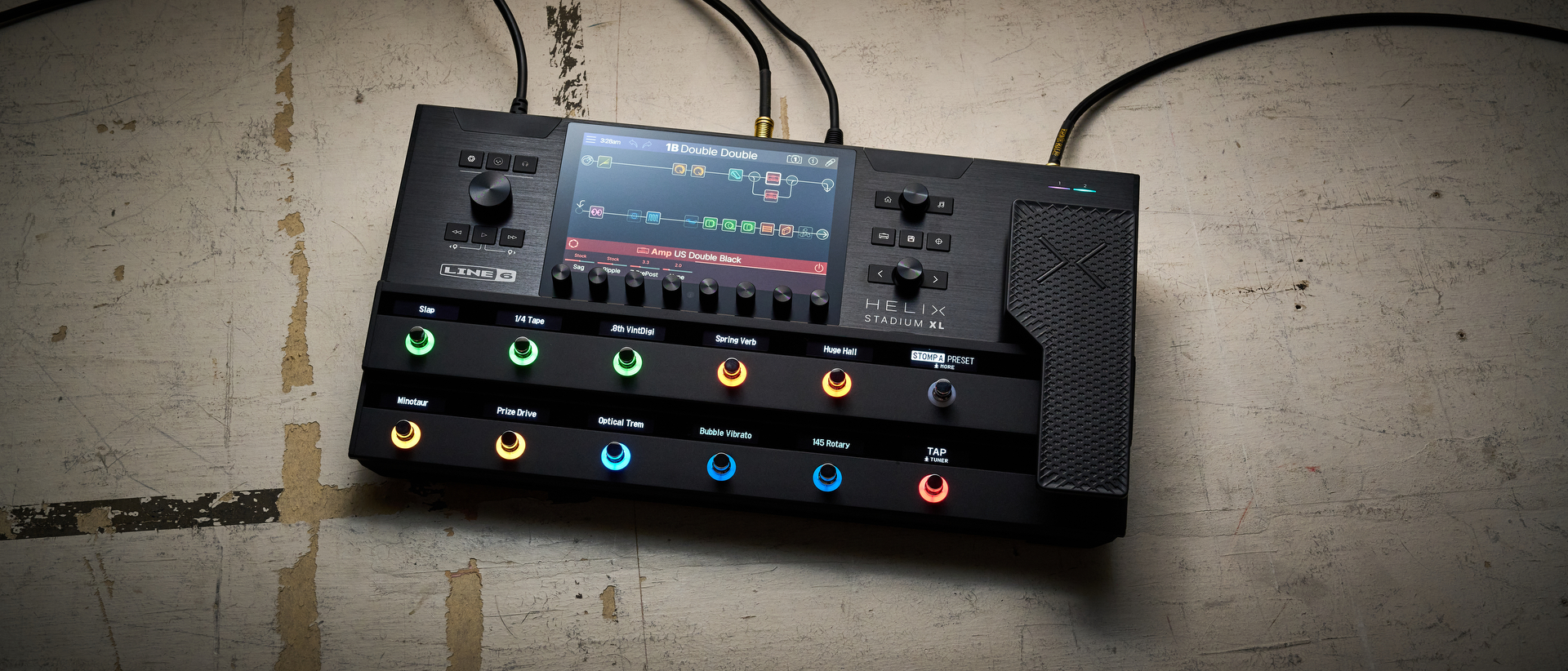6 scales from around the world that every guitar player should know – and how to use them
Tired of the same old blues scales and pentatonics? Try these on for size…

As guitarists, we’re always looking for new sounds and inspiration, and love to explore new techniques. But if you still find yourself trapped in the confines of pentatonic and major scales, a good way to break this harmonic stalemate is to explore new-sounding scales.
Although most popular music, rock included to some extent, has a fairly familiar ‘westernised’ sound, music from other countries often carries distinct characteristics that reflect culture, tradition, and history. Just compare music from Japan to the sound of popular western music and you’ll hear many different aspects, from instrumentation to scales and harmony.
Japanese music emphasises different intervals, too, and understanding the formulas of these more unusual sounding scales is a rewarding area for us musicians. Well-known players that have exploited the these scales in western music include John McLaughlin, Al Di Meola, Marty Friedman, Jason Becker, Joe Satriani, Yngwie Malmsteen, and Ritchie Blackmore.
In this feature we will focus on six scales, three minor and three major, all of which have their own intervallic DNA, with unique sounds and unusual chordal possibilities.
Although such scales are often used over specific chords, especially in jazz to outline the colourful construction of altered chords, the scales presented in this feature work great for composing chord progressions, riff writing, and soloing.
Each scale has been illustrated from an A root note for ease of learning, as well being able to compare the differences between their harmonic structures. I have presented one shape for each scale, but strongly advise you to explore all the positions of each one, starting from every note. We’ll move into different keys when we apply the scales in this article’s mini pieces, a little later on.
For maximum appeal, I’ve approached the subject from more of a rock angle as opposed to jazz, focusing on how we can harmonise the scale to produce different chord families, write exciting new sounding riffs, plus explore soloing concepts.
All the latest guitar news, interviews, lessons, reviews, deals and more, direct to your inbox!
The Hirajoshi is our first of three Minor scales, and is a Japanese pentatonic scale with a formula of R-2-b3-5-b6. Great examples of this scale can be heard in the playing of both Jason Becker and Marty Friedman. Try experimenting with intervals, especially the semitone distance between the 2nd and b3rd, as well as the 5th and b6. This is a great scale to add flavour and mystique to your Aeolian (minor scale) soloing.
The Hungarian Gypsy is our next minor scale and is very dark sounding, with its formula of R-2-b3-#4-5-b6-7. This scale is great for composing sinister-sounding riffs and licks, and has been used by Joe Satriani. Its unique sound comes courtesy of the chromatic groupings, which result in some interesting chordal and melodic possibilities. The Hungarian Gypsy scale is the fourth mode of the double harmonic scale, and is a great choice over minor/major 7th chords.
The Arabian scale is our final minor offering, although it is actually a diminished scale. The Arabian scale consists of eight notes (R-2-b3-4-#4-#5-6-7), and is the same as the diminished whole-half scale.
The Chinese scale is our first major scale and is in fact an inversion of the Japanese Hirajoshi scale we opened this lesson with, but starting from the 4th interval. Its formula is R-3-#4-5-7, and the scale is a great alternative for soloing over Lydian progressions.
The harmonic structure of this scale also introduces semitone distances which are great for creating haunting yet beautiful dissonance when soloing over a major chord, or a major chord that includes a #4 or #11. This one is another favourite of the great Marty Friedman.
The Byzantine, also referred to as the double harmonic scale, has a formula of R-b2-3-4-5-b6-7 and makes for an interesting alternative to the major scale when soloing over major 7th chords.
You could view it as a major scale with a b2 and b6. It also makes for a refreshing alternative to the Phrygian Dominant when composing Eastern-style metal riffs. Once again the chromatic notes make for some interesting harmonic lines and intervals. This scale was famously used by Dick Dale for the melody of his classic instrumental, Miserlou.
Our final scale, the Oriental, is the fifth mode of the Byzantine/double harmonic scale. Featuring the formula R-b2-3-4-b5-6-b7 it works as an alternative for soloing over Dominant chords, particularly the 7b5, but again can be used in its own right for composing riffs, progressions and solos.
There’s a lot to get your teeth into here, but don’t let that daunt you. A little work put in now will be greatly rewarded later on.
Get the tone
Amp Settings: Gain 7, Bass 7, Middle 8, Treble 7, Reverb 3
For this lesson I used a mixture of clean and driven tones. For the clean tone aim for a pristine clean like that used by Marty Friedman. Try using a single-coil pickup and a compressor pedal if you have one, plus a large reverb. For the driven tone aim for a thick, middly distortion with clarity and separation. Push the gain a little more for the solos as well as adding delay.
The scales you need to know
Example 1. The Hirajoshi Scale – Key of a (A-B-C-E-F)
Bars 1-4 We kick things off with an arpeggio figure based around the chords of A minor and F Major, extended to highlight the scale’s stronger intervals, giving the progression a rich mood and evoking a sound of this Japanese scale.
Bars 9-12 Our second riff makes use of a powerful, overdriven tone. Once again we highlight the characterises of the Hirajoshi, the total centre based around A minor, but pedalling off the open fifth string with tight palm muting.
Again, we highlight the strong and unusual intervals of the scale, highlighting the 2nd and b6 intervals again within the A minor totally, plus the #4 against the F major. This section and the previous chord clusters and their intervals produce a beautiful yet haunting dissonance.
Bars 17-18 Here’s our solo, with some Marty Friedman and Jason Becker-inspired phrasing, including outside notes moving into scale tones, plus a powerful descending figure that highlights the close intervals.
Bars 19-21 We conclude this piece with an ascending lick that shifts in octaves and has a strong Japanese sound. Take care with the speed of this figure, especially when crossing positions.
Example 2. The Hungarian Gypsy Scale – Key of E (E-F-G-A#-B-C-D#)
Bars 1-4 Our first section includes a selection of chords that are constructed from the E Hungarian Gypsy scale. Take care with the 16th-note rhythmic syncopations; repeat the audio if you find it difficult.
Bars 9-12 Here’s our main riff, and in contrast to the clean intro section it should be performed with a driven tone. This pedals off the sixth string and highlights the semitone intervals, as well the scale’s chromatic elements.
I have outlined the angular quality of the scale with a slightly awkward string skipping section, so take care. This riff also includes a section of diatonic 3rds that outline the chords of G major, F# augmented, D# diminished and C minor.
Bars 17-19 The solo kicks off with some Marty Friedman-style string bends, before a descending diatonic arpeggio based around C major and B major, and concludes with an E minor figure that outlines the minor/major 7th tonality of the I chord. This is followed by more stylistic bends.
Bars 20-21 We conclude things with an ascending 16th-note triplet legato run played on the top two strings. Pay attention to the wide stretch fingerings required to accommodate the unusual DNA of this scale.
Example 3. The Arabian Scale – Key of B (B-C#-D-E-F-G-G#-A#)
Bars 1-4 This B Arabian scale example starts with some clean chords performed with rakes and whammy bar scoops. The chords have a dark and unsettling sound, and we can include both an E minor and an Em7b5 chord from its chord family. It presents some interesting chord options when analysed.
Bars 9-12 This section features an angular sounding riff that pedals off of the B root note. Pay attention to your picking hand as you’ll have to cross strings as you maintain the pedal tone.
Bars 17-18 This run illustrates the symmetrical nature of the scale, and maintains the same finger permutation while crossing all six strings as it ascends.
Bars 19-20 Here a descending diminished 7th arpeggio ends with a full six-string shape. Pay attention to the position shifts, while maintaining the pattern.
Bars 21-23 Our solo concludes with ascending run that once again demonstrates the symmetrical layout of this scale.
Example 4. The Chinese Scale – Key of C (C-E-F#-G-B)
Bars 1-4 Here’s our first major idea, with chords constructed from the C Chinese scale. As this scale is closely related to the Lydian mode the chord progression outlines the #4 interval as well as the major 7th.
Bars 9-16 This picked arpeggio figure again underpins the #4 interval, as well as demonstrating how we can construct clusters of notes to imply harmony.
Bars 17-18 Our solo features some stylistic oriental inspired phrasing, achieved by bending the first note of each phrase by pulling the string down.
Bars 19-21 We conclude this example with a double-picked descending line, reminiscent of something Marty Friedman would play, before we conclude with the final cascading chord.
Example 5. The Byzantine Scale – Key of E (E-F-G#-A-B-C-D#)
Bars 1-4 As our opening riff kicks off, it features a pedal tone figure that includes diatonic 3rds which outline the chords of F major and E major, creating a strong Eastern sound that typifies the Byzantine scale.
Bars 9-12 Here we encounter a second pedal tone riff that includes more diad or double-stop ideas against the E pedal tone, once again capturing the mystical flavour of this very musical-sounding set of notes.
Bars 17-18 The solo starts here, with some string bends, speedy slurs and slides, all designed to highlight the chromatic nature of the scale. This is followed by an ascending 16th-note triplet idea performed on the top two strings. Pay attention to the speed of this lick as it’s made more tricky due to the position shifts.
Bars 19-21 We come to the end of the solo with more stylistic string bending phrases, which concluding with a descending G# Minor arpeggio.
Example 6. The Oriental Scale - Key of D (D-E Flat-F#-G-A flat-b-c)
Bars 1-4 We start with clean chords highlighting the Altered chord tonality of the D7b5 as well as the Ab/D. This intro also includes an Eb Augmented chord, giving you some indication of the harmonised chords available in this scale. Pay attention too, to the piece’s progressive rock 5/4 time signature.
Bars 9-12 The riff has a strong Joe Satriani feel, harmonically and rhythmically. We pedal off the open fourth string to underpin the key centre while shifting the harmony, playing double-stops on the third and second strings.
Bars 17-18 The solo gets underway with an extended figure that begins with an Ab7 arpeggio and concludes with a powerful line that outlines the Dominant b7 elements of the Oriental scale.
Bars 19-21 Our solo, and indeed this feature, finishes off with an interesting descending lick that borrows ideas from familiar blues-rock phrasing but with a harmonic twist due to the scale’s chromatic layout. The solo ends in style with some tasty blues phrasing that again outlines the sound of the D7b5 chord.
Jamie Humphries is an English guitarist based in Sweden. He has toured and performed with artists such as Brian May, Queen, Jeff Beck and Henry Rollins, as well as performing across Europe for We Will Rock You and in America with the Australian Pink Floyd Show. He was a longtime contributor to Guitar Techniques magazine and contributes lessons for Gibson. He runs his own studio in Stockholm where he produces Youtube content for Six String Alliance and Produce Like A Pro. He is a Music Man and Mesa/Boogie endorsee.





